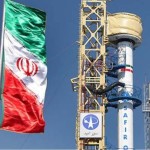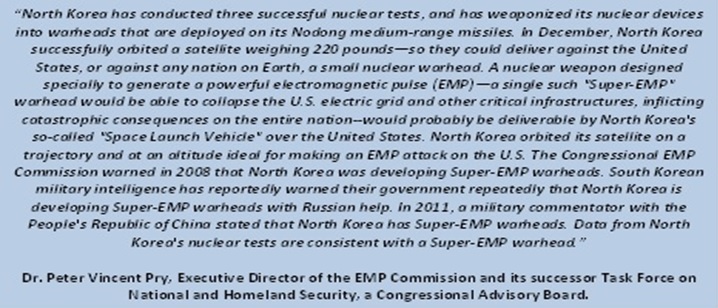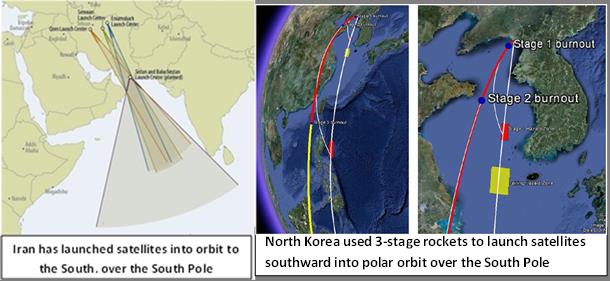Amb. Henry F. Cooper, Chairman Lt. Gen. Daniel Graham, Founder
High Frontier . . Building Truly Effective Defenses . . . Reagan’s Vision Lives!
E-Mail Message 140417
Defeat Iran’s FOBS!
By Ambassador Henry F. Cooper
April 17, 2014
Iran, like North Korea, has demonstrated an ability to launch nuclear weapons into low earth orbit over the South Polar regions. Last year, they launched a monkey into space in such a trajectory, reportedly in a 4400 pound capsule that could easily carry a conventionally designed nuclear weapon into orbit. If they launched a much lighter “EMP” nuclear weapon believed to be in the North Korean inventory, they could achieve substantially higher orbits. (Detonation of either weapon over the U.S. could lead to the death of several hundred million Americans within a year.) These facts, coupled with geographic realities, make defending against an Iranian FOBS more difficult than is the case for North Korea. And the Iranian Mullahs may be more inclined to attack “the Great Satan” than is North Korea’s Dear Leader. We can and should quickly end our vulnerability to both emerging if not existing threats.
For the past two weeks, my email messages focused on the need to defeat the ballistic missile threat from North Korea, particularly a nuclear armed fractional orbital bombardment system (FOBS) that would approach the United States from our undefended south. Those email reports are available on our webpage, www.highfrontier.org . Following a brief recap of those concerns, I will emphasize the somewhat more problematic Iranian FOBS threat.
Recap of NY Session on North Korean FOBS Threat.
Last Thursday, I was privileged to brief the attendees at the New York City Explorers Club in a session graciously hosted by Mr. Robert Laidley, President of the Atlantic and Conservation Institute. The focus was on the existential electromagnetic pulse (EMP) threat posed by North Korea.
I followed Dr. Peter Vincent Pry, who discussed North Korea’s threat capabilities—particularly their possibly planned and tested exploitation of a specially designed EMP nuclear device to kill several hundred million Americans. Dr. Pry considered these issues in considerable detail in Pages 260-263 of his exhaustive study, APOCALYPSE UNKNOWN: The Struggle to Protect America from An Electromagnetic Pulse Catastrophe, which is available on Amazon.com. His April 5, 2013 Family Security Matters article, “A North Korean Nuclear Pearl Harbor,” summarizes the situation as follows:
Click here for the High Frontier leave-behind article summarizing my views and recommendations. The following is a brief abstract of my talk. My recommended actions are quite specific, involving inexpensive adjuncts to our already deployed and operational ballistic missile defense (BMD) systems.
“A combined diplomatic and technical response is proposed to counter effectively North Korea’s demonstrated FOBS capability, which poses an existential EMP threat to the American people. We should insist on inspecting their satellite payloads for launches over the South Polar regions, and if they refuse be prepared to shoot down their satellites before they overfly U.S. territory. We should deploy a layered set of sea- and land-based defenses to do so, beginning almost immediately—and for relatively little expense since existing mostly already funded defense capabilities would be involved.”
Dealing with the Irainian FOBS Threat.
My main message today is to remind our readers that North Korea is not alone in posing this existential threat. Iran is North Korea’s partner in developing and testing nuclear weapons and ballistic missiles to deliver them, and they also have demonstrated a FOBS capability by launching multiple satellites southward over the South Polar regions. If such satellites were to carry nuclear weapons they could be detonated over the United States to create an EMP. My April 8, 2013 email message extended Dr. Pry’s above discussion of the North Korean launch of a 220-pound EMP device payload to discuss key orbital parameters, repeated in my last message.
Then, our April 24, 2013 message, among other things, shows the picture of a Monkey that Iran launched into space in a capsule reported to weigh 4400 pounds—20 times the reported North Korean payload weight and lots more than needed to carry a more traditionally designed nuclear weapon. Of course, they could launch the lighter nuclear payload that North Korea tested into a substantially higher altitude orbit than North Korea achieved.
The left-hand figure below illustrates the possible southern launch trajectory tracks from sites Iran has used to launch its satellites. The right hand figures, associated with North Korea’s satellite launches, illustrate typical trajectories that would apply for both North Korean and Iranian space launches. They also indicate important geographic differences that will influence deployment of effective defensive counters for Iran and North Korea.
It should be possible to get an Aegis BMD ship close enough for its SM-2 Block IV interceptors (with appropriately updated targeting software algorithms) to shoot down an Iranian nuclear-armed satellite while it is boosting from its southern launch site. But, because of the distances between possible ship locations and the target rocket trajectories, a boosting rocket launched from Iran’s northern inland launch sites seems likely to be more difficult to counter with sea-based boost-phase defenses.
With cuing information from an appropriately located TPY-2 radar, the Aegis SM-3 interceptors could have a good shot at shooting down the satellite after it is in orbit. The same TPY-2 radar could cue the ground-based interceptors on Vandenberg AFB, CA to intercept the Iranian nuclear armed satellite.
The bottom line is: We can quickly provide our existing sea and land-based BMD systems with an ability to shoot down some Iranian nuclear-armed satellites, but successfully intercepting others is likely to be more difficult than was the case for North Korean nuclear-armed satellites.
There are also important political differences between dealing with North Korea and Iran. North Korea’s Dear Leader may be a serious threat, but also may care more about preserving his regime than Iran’s ruling mullahs, who have sworn to kill as many Americans as possible.
We’re the Great Satan, you see. What better way is there to achieve their aims than an EMP attack? And threats of retaliation are not likely to impress those who are prepared to commit suicide to destroy the Great Satan.
Still, I believe that, with slight modifications, my recommended strategy for countering a North Korean FOBS also makes sense for dealing with Iran:
- In addition to a declaratory policy threatening retaliation, the U.S. should demand that all Iranian satellite launch payloads be inspected by an appropriate body in which we have confidence—e.g., the International Atomic Energy Agency (IAEA). If not, it should be our policy that we will shoot down such satellites so launched. And we should initiate programs to back up this strategy, particularly to deploy an appropriately sited a TPY-2 radar to enable our currently operational defenses, as discussed in the following steps.
- Upon warning (e.g., Iranian satellite launch site preparations) and in the absence of such an independent payload inspection, move Aegis BMD ships in position to counter an Iranian satellite launch—either in boost phase or, with the aid of an appropriately sited TPY-2 radar, after its satellite is inserted into a southern directed orbit. The Aegis ship Captain should be pre-authorized by appropriate authorities, consistent with the warning provided by step one, to assure the intercept can be carried out without delay after the threat Iranian satellite is launched. This requirement is no different than would be the case for any boost-phase, ascent-phase or early mid-course phase intercept defense. To assure high confidence, two interceptors might be fired.
- The ground based interceptors currently deployed at Vandenberg AFB in California probably have the range capability to intercept a FOBS from Iran, if the Vandenberg command and control system is provided appropriate orbital parameters to cue its interceptors into the right battle space. The same radar recommended in step 2 should be able to provide this needed cuing information. Since the Ground Based Interceptor system test record suggests only a 0.5 single shot kill probability, several interceptors—perhaps all four based at Vandenberg—should be launched to assure a high kill probability. (A shoot-look-shoot strategy could reduce the number required.)
- Finally, even a layered defense will not be perfect, so the electric power grid should be hardened as a top national priority. The appropriate strategy would be to harden first the critical nodes of the grid—particularly their extra high voltage (EHV) transformers, which are not easily replaced and the survival of which would assure the grid can be quickly reconstituted after such an attack provided other critically important components that could be destroyed by the EMP are stockpiled. Implementing this strategy could take years, so we should enable a layered defense as quickly as possible. As noted above, we can and should immediately take inexpensive high-payoff steps to exploit our already existing BMD operational capability.
An adjunct to these steps should be to prepare to destroy the satellite launch vehicles on their launch pads—as former Defense Secretary William Perry and former Deputy Defense Secretary Ashton Carter originally recommended in their June 8, 2008 Washington Post article to deal with North Korean nuclear-armed ICBM threat. The EMP from a southward launched nuclear armed satellite is currently much more dangerous than the ICBM threat, for which we have deployed at least a limited defense. We are completely vulnerable to the FOBS attacks from the south.
Dysfunctional Washington and our National Challenge.
This existential threat is well known among experts—especially since it was emphasized by a Congressional EMP Commission in 2004 and 2008—and validated by a number of subsequent studies, including by the National Academy of Sciences. Dr. Pry has often discussed and published his informed views, including in articles co-authored with former CIA Director James Woolsey, e.g., click here for their memorable “American Blackout” article last November.
Yet little or nothing is being done to counter this threat or to harden our critical infrastructure to survive such an attack.
And Washington is seriously broken.
A growing number of Americans, particularly at the grass roots level, are learning about this threat—and are dismayed by the dysfunctional efforts of the Washington establishment, by members of both the executive and congressional branches, who are failing in their sworn Constitutional duty to provide for the common defense. I have written about this dysfunction (beginning with my February 25, 2013 “Who’s on First” email report) and the, until now, unimpeded efforts of lobbyists for the electric power industry who have so far blocked congressional efforts to deal with the threat.
There also is little to show for the executive branch during the past year—members of the Department of Homeland Security (What a misnomer!) still do not even include the existential EMP threat among the dozen or so threat scenarios that they mandate be addressed by all U.S. government departments and agencies. Defense Department officials, who probably best understand the threat and how to harden against it, still don’t think it’s their responsibility to provide for the common defense by hardening the critical infrastructure upon which the U.S. military critically depends. Department of Energy officials are awake to the lack of resilience of the electric power grid, but still seems to be more focused on other threats to the grid. And still, no below the President is in charge of knocking heads and bringing order out of this chaos.
In short, I believe this condition is pure folly for our nation and all we hold dear, because I know from my Cold War experience of overseeing major programs to harden our strategic systems to EMP effects that the threat is quite real, that we know how affordably to harden our critical infrastructure to operate through such an attack, and that the key problem blocking our progress is politics.
Thus, Peter Pry and I, like many of our colleagues, believe it is critically important to take our message to state and local authorities, as well as the American people—if they begin to understand, they will demand that Washington’s leaders live up to their sworn duty to the Constitution and “provide for the common defense.”
I hope that Robert Laidley and his colleagues in New York, with whom we shared our views last week, will help this important cause.
No Time To Waste!
Very little new investment is needed to execute the first three of the above recommendations immediately, since the proposed approach exploits system components already either operational or under fully funded development programs. Secretary Hagel’s decision to increase the presence of our Aegis BMD ships to help defend Japan and the U.S. from North Korea is certainly a step in the right direction. But these steps are no help in dealing with Iran, which is a more difficult problem as noted above.
We need to make all our existing defenses all they can be! ASAP!
And we need more capable defenses for a future growing more dangerous as Vladimir Putin extends a Cold War shadow over Russia’s near abroad. Don’t forget that the Obama administration essentially ceded leadership to Putin in dealing with problems in the Middle East, especially with Russia’s erstwhile allies in Syria and Iran.
Congressional “powers that be” should consider these issues with great care and at least assure that the Pentagon considers the recommendations in our past two email messages. The Pentagon should do so in responding to Section 238 of the 2014 National Defense Authorization Act (NDAA) that directs Defense Secretary Hagel (in consultation with the Commanders of U.S. Strategic Command and U.S. Northern Command, and the Director of the Missile Defense Agency) to consider options to defend the U.S. homeland from ballistic missile “threats that approach the United States from the South . . .”
Both North Korean and Iranian FOBS pose just such a threat.
Near Term High Frontier Plans.
We will do all we can to encourage “the powers that be” to “make the Navy’s Aegis BMD system all it can be” and to adopt the anti-FOBS strategy laid out in our past two email messages.
We will support Robert Laidley’s efforts to inform his colleagues in New York about the EMP threat and what can be done to counter it.
We will continue our efforts to inform state and local authorities about the EMP threat and expand our work with the National Guard to help them gain knowledge and workable plans to help harden the electric power grid and counter the EMP threat. This work should go hand in hand with the efforts to gain support from State legislators to expand on the excellent work in Maine and Virginia, which have passed legislation requiring serious studies of the EMP threat and the needed countermeasures to protect the electric power grid.
A recent bill passed in record time without single negative vote in Virginia can be used as a ready pattern.
We will continue working with South Carolinians to build a coalition to engage constructively with private citizens and their local and state representatives and other authorities to work with the SC National Guard in understanding and responding to this serious threat. We will expand this effort to neighboring and other states.
We are informing SC state legislators and senators about the threat and what can be done to deal with it—and hopefully they will follow Maine, Virginia and others in seeking to harden the electric power grid. We also expect support from Cong. Jeff Duncan (R-SC) whose district includes my SC farm—and who is a member of the Congressional EMP Caucus seeking passage of the Shield Act and the Infrastructure Protection Act, as well as other SC representatives.
We will be working with members of the EMP Coalition and others who are seeking to take our message across the country—especially with Bob Newman, a former Adjutant General of Virginia to help us link our SC plans more broadly and especially into Virginia and the National Capital region.
What can you do?
Join us in praying for our nation, and for a rebirth of the freedom sought, achieved and passed to us by those who came before us.
Help us to spread our message to the grass roots and to encourage all “powers that be” to provide for the common defense as they are sworn to do.
Begin by passing this message to your friends and suggest they visit our webpage, www.highfrontier.org for more information. Also, please encourage your sphere of influence to sign up for our weekly e-newsletter!
And support us with your tax deductible gifts to help enable our continuing efforts.
Please click here to read Past Weekly Updates!
Please click here to read past Flash Messages!
Please help High Frontier continue this important and timely work!
Be sure to follow us on our Social Sites!
If you found this letter via our Social Sites, and you would like to subscribe, please click below!








